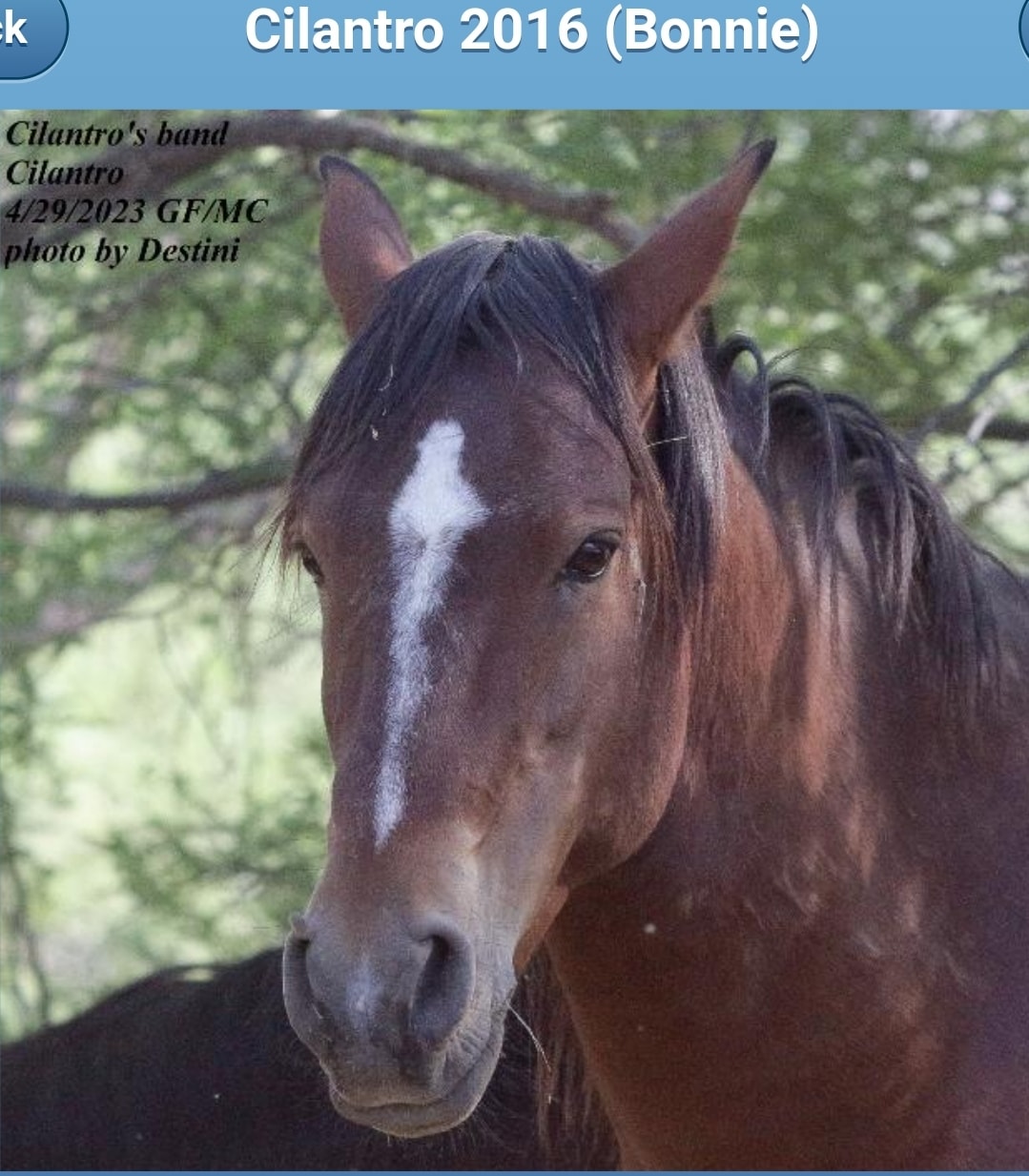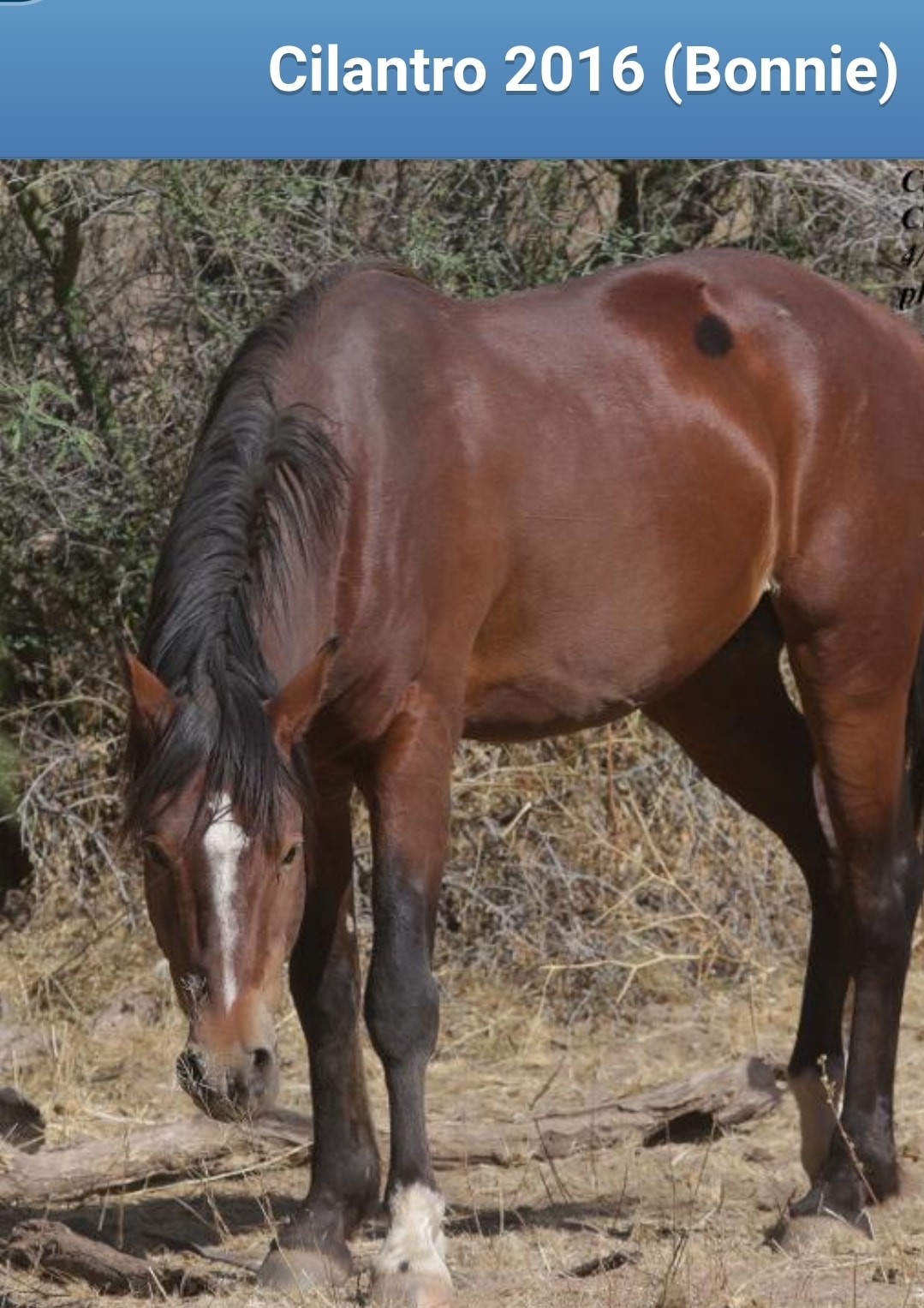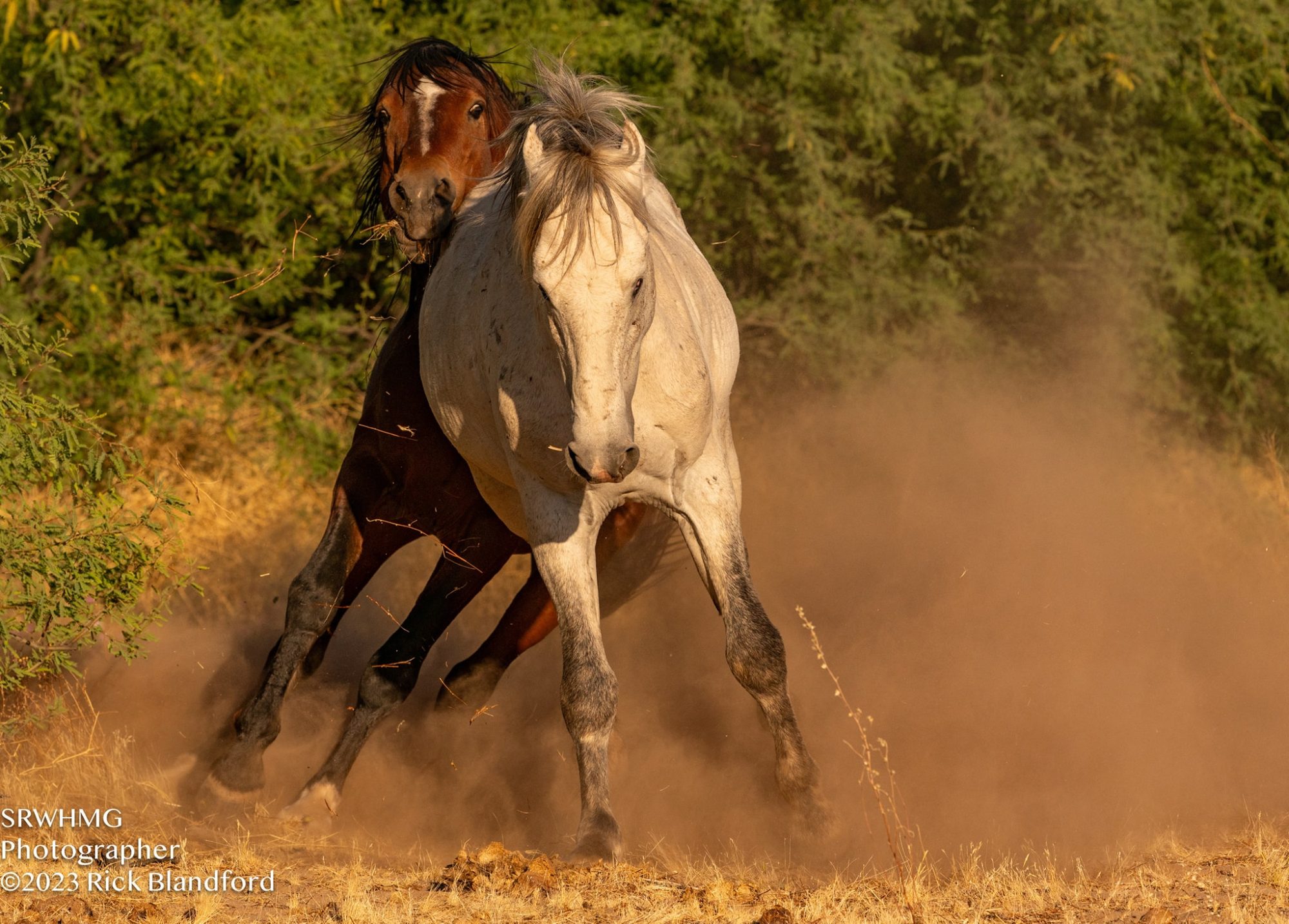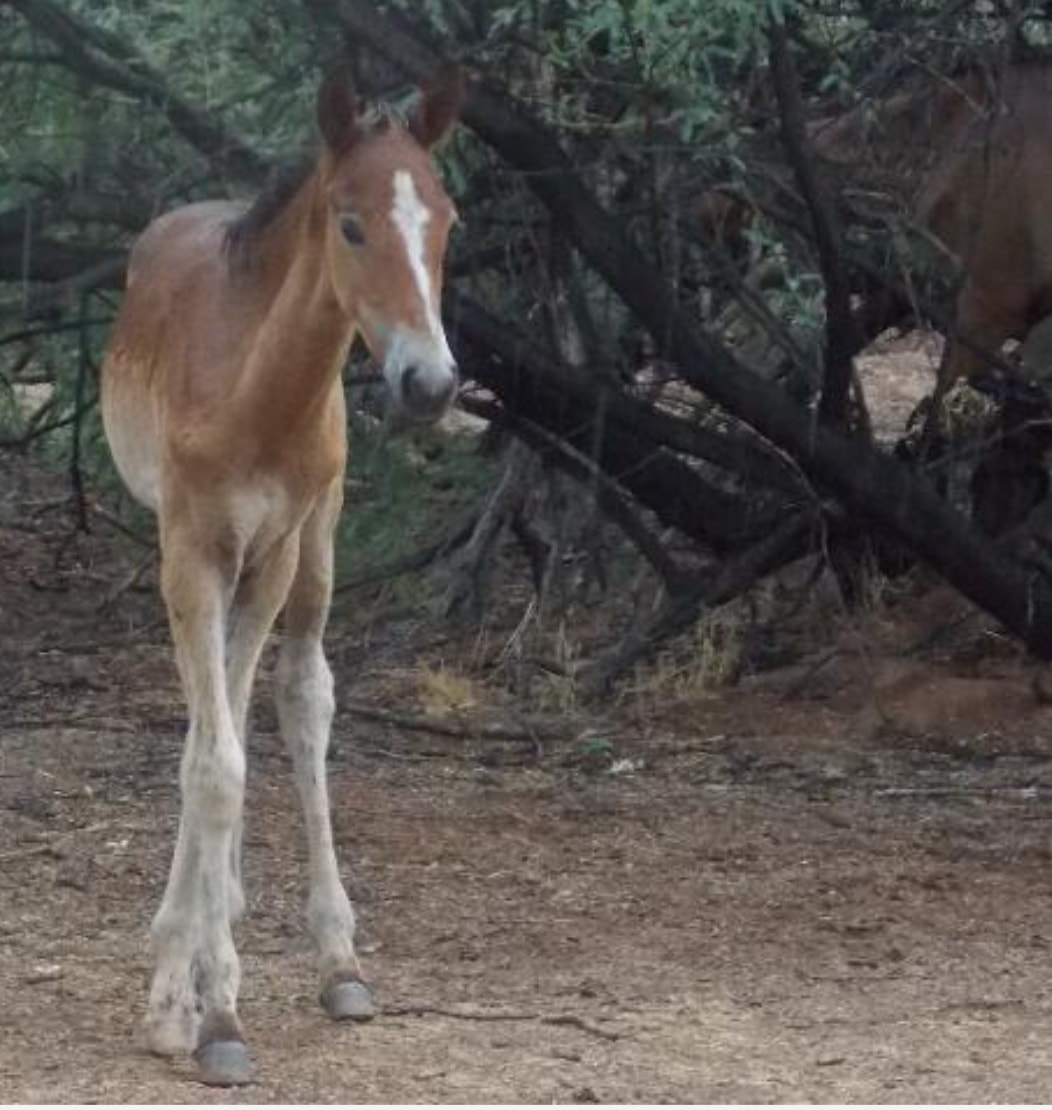
✨️Salt River Star Stallion : Cilantro.
August 14
As most of you know we keep track of all of the Salt River wild horses. Cilantro is our up and coming star; at just 7 years old his little band is growing fast!
Often people ask us if we keep track of them by microchip or tracker, which would be cool, but it’s done purely by volunteer sightings, that get logged in our database app each time. Decades of sightings and details about every horse and every family band, make it possible, as well as fun, to manage wild horses successfully.
So Cilantro was born in March of 2016 and he was simply adorable, plus confident from the very beginning. We have so many pictures of those first days in our app, just like we have of each horse born in Salt River habitat.
We believe that comprehensive record keeping is key to efficient management. Unfortunately, the government entities charged with the protection of wild horses, haven’t caught on to this yet and that’s why they say that PZP doesn’t work and that they have to spend millions on removing wild horses instead. Each year they ask congress for more money to do this.
Basically they are chasing the growthrate every year, which really can be as high as 20%. In the best case scenario, they then stuff the poor homeless horses in pens for the rest of their lives, without their families, at the expense of you know who. We do not even need to discuss the worst case scenario to know that the roundups are basically a never ending cruel cycle, unsustainable but also plain dumb in our opinion.
Because, as is plain to see for everyone on the Salt River, PZP fertility control does work and amazingly well. The difference is in dedication and a real interest in the horses, which we sadly don’t find with either agency mandated with their protection.
Anyway, let’s get back to our star stallion Cilantro. His mother is Bonnie, who sadly passed away in 2021 during mesquite bean season, from colick. His grandmother is Fiona who was sadly hit on the road in 2018, right before the road fence was finished. (*We placed a gate in the spot where she had crossed and it’s named Fiona’s gate. It’s right after the bridge on the left side. Please always close the gate to prevent another tragedy! )
So Cilantro has a maternal bloodline that is precious and also rare. His Sire is the mighty Cisco who has maintained a huge band for the past 14 years. Cilantro looks just like him in conformation and his deep bay color. The only difference is in Cilantro’s blaze, which kindof looks like an upside down sword.
Their bloodlines are important to us, because we are unnaturally manipulating the birthrate after all. We believe that we have the longest bloodline records on wild horses anywhere, up to 8 generations. Our goal, in coordination with the AZDA, is lowering the population, but also keeping it genetically viable into the future.
In addition to our records, we have been collecting DNA for many years for research with Dr. Gus Cothran, a well-known geneticist.
We closely study each horse throughout the different stages of his/her life, and try to find as many consistent patterns as possible.
Did you know that not much actual research has been done about wild horses? Its true, more research can be found about zebras in Africa, than about wild horses in America. While we do not have enough funds to hire a scientist, we sure do have enough data spanning almost 3 decades now. We can show any legitimate scientist who is interested.
Want to know more? We love sharing our knowledge, but please always name your source, when you repeat something you’ve learned here. We are SRWHMG for short. And of course please share our posts anywhere you like.
So then let’s get back to our star Cilantro. Like every other wild stallion, we know he will go through 4 main phases in his life, and he is currently in phase 3; the prime of his life as a lead stallion.
Here are all the phases:
Phase 1: They are a foal/yearling with their birthband first, for a few years, learning everything about the wild from their parents, until they get emancipated. This happens between 1.5 years old and 4 years old, (on average around 2 years of age) when they get kicked out by their father, the lead stallion. It’s kind of like when your 25 yr old still lives with you, and they need to go find their own apartment.
(Stallions who forget to kick their sons out, sometimes get kicked out by their own sons, once they get too strong. So being too kind can cost you, if you are a lead stallion.)
Next, in Phase 2, they become a bachelor stallion. Because they are social creatures, they always find some other bachelors to hang out with and they can be very close for several years. During this time they practice sparring, gain their strength, and seem like a rowdy bunch of troublemakers. Phase 2 can be compared to an age of about 18 to 25 in human years. (No offense to any young men.)
Cilantro during this phase, was good buddies with his half brother of the same age, both from Cisco, but out of different mothers. His brothers name is Caraway, (also an herb) and watch out if you saw the two of them come around!
Phase 3 is between 7 and approximately 20 years of age; the prime of their life. Cilantro is at the start of this phase. All stallions are now either a lead stallion, or a first or second lieutenant stallion, except for a few who are “just” a follower or a loner, usually caused by an ailment of some sort.
It is interesting to watch the transition between phase 2 and 3, when they turn from little bachelor into a full grown stallion with a massive neck, caused by the increase in testosterone. During this last stage of phase 2, they become a serious threat for older lead stallions to contend with, because they are now ready to conquer their own mares.
Sometimes they will haunt a band and steal a mare, but other times an older lead stallion might die, leaving a hole band without protection, like stallion Timber did in 2021, which was sad. Without wasting any time at all, Caraway and Cilantro took that opportunity and took off with Timber’s band.
We were hoping they would stay together, but they ended up going their seperate ways, each with a mare and filly pair, which is a great start to their own families.
Since then we’ve seen Cilantro work hard to gain 4 more mares, for a total of 6, and he is still looking for more. It looks like he might follow in his dad’s footsteps of overachiever. He loves his mares and will kick any other stallions’ butt, if they even look at them sideways.
Usually we watch a lead stallion throughout his life in phase 3 for many years holding on to their bands reliably, unless they get injured, in which case they may lose their hole band. Between the age of 7 and 18-20 they are very vigilant in watching over their band, working together with their lead mare, and raising their offspring. It is hard work being a lead stallion, and they don’t take any breaks.
Phase 4. By the time they are between 18 and 20 lead stallions start to look worn out, and are not able to defend their bands as well. This is when the next generation of bachelors will come in and the lead stallion can loose all of his band at once, or loose mares left and right until he has only one or none left.
This seems a sad phase of their lives, as they are now a bachelor once again. But there is a big difference, you won’t see them doing any effort anymore to conquer any mares. They seem complacent and actually fairly happy to take it easy without any responsibilities. This phase is comparable to a grandfather sitting in his rocking chair. For the first time in their life they get to be lazy and take it easy.
We call these stallions retired stallions, and we have over a dozen of them on the river! They are old, but they can live many more years like this in quite good health.
But our Cilantro has a long promising career ahead of him, before he gets to this phase. We are looking forward to watching this beautiful stallion and his band live their hole lives wild and free and teach us many more things.
We for one, will never stop fighting for their right to stay wild and free and for you the public to be able to see the amazing behavior of these icons in the wild. If you agree, please share our tidbits of wild horse wisdom and join us in our important mission.
Thank you!! SRWHMG.
Written by Simone, proprietary information owned by SRWHMG.
Pictures from our database app by Destini R, Simone N and Rick B.



